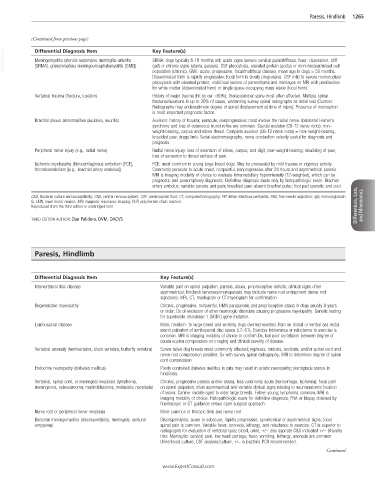Page 2526 - Cote clinical veterinary advisor dogs and cats 4th
P. 2526
Paresis, Hindlimb 1265
(Continued from previous page)
VetBooks.ir Differential Diagnosis Item Key Feature(s)
Meningomyelitis (steroid-responsive meningitis-arteritis
SRMA: dogs typically 6-18 months old; acute signs (severe cervical pain/stiffness, fever, depression, stiff
gait) or chronic signs (ataxia, paresis). CSF pleocytosis, elevated protein (acute) or mononuclear/mixed cell
[SRMA], granulomatous meningoencephalomyelitis [GME])
population (chronic). GME: acute, progressive, focal/multifocal disease; mean age in dogs = 55 months.
Disseminated form is rapidly progressive; focal form is slowly progressive. CSF mild to severe mononuclear
pleocytosis with elevated protein; multifocal lesions of parenchyma and meninges on MRI with predilection
for white matter (disseminated form) or single space-occupying mass lesion (focal form).
Vertebral trauma (fracture, luxation) History of major trauma (hit by car ≈50%); thoracolumbar spine most often affected. Multiple spinal
fractures/luxations in up to 20% of cases, warranting survey spinal radiographs as initial test (CAUTION:
Radiographs may underestimate degree of spinal displacement at time of injury). Presence of nociception
is most important prognostic factor.
Brachial plexus abnormalities (avulsion, neuritis) Avulsion: history of trauma; peracute, nonprogressive; most involve the radial nerve. Ipsilateral Horner’s
syndrome and loss of cutaneous trunci reflex are common. Caudal avulsion (C8-T2 nerve roots): non–
weight-bearing, carpus and elbow flexed. Complete avulsion (C6-T2 nerve roots) = non–weight-bearing,
knuckled paw, drags limb. Serial electromyography, nerve conduction velocity useful for diagnosis and
prognosis.
Peripheral nerve injury (e.g., radial nerve) Radial nerve injury: loss of extension of elbow, carpus, and digit; non–weight-bearing; knuckling of paw,
loss of sensation to dorsal surface of paw
Ischemic myelopathy (fibrocartilaginous embolism [FCE], FCE: most common in young large-breed dogs. May be proceeded by mild trauma or vigorous activity.
thromboembolism [e.g., brachial artery embolus]) Commonly peracute to acute onset, nonpainful, nonprogressive after 24 hours and asymmetrical paresis.
MRI is imaging modality of choice to evaluate intramedullary hyperintensity (T2-weighted), which can be
prognostic and presumptively diagnostic. Definitive diagnosis made only by histopathologic exam. Brachial
artery embolus: variable paresis and pain; knuckled paw; absent brachial pulse; foot pad cyanotic and cool.
C&S, Bacterial culture and susceptibility; CNS, central nervous system; CSF, cerebrospinal fluid; CT, computed tomography; FIP, feline infectious peritonitis; FNA, fine-needle aspiration; IgG, immunoglobulin
G; LMN, lower motor neuron; MRI, magnetic resonance imaging; PCR, polymerase chain reaction.
Reproduced from the third edition in unabridged form. Differentials, Lists, and Mnemonics
THIRD EDITION AUTHOR: Dan Polidoro, DVM, DACVS
Paresis, Hindlimb
Differential Diagnosis Item Key Feature(s)
Intervertebral disc disease Variable pain on spinal palpation, paresis, ataxia, proprioceptive deficits; clinical signs often
asymmetrical; hindlimb lameness/monoparesis may indicate nerve root entrapment (nerve root
signature); MRI, CT, myelogram or CT/myelogram for confirmation
Degenerative myelopathy Chronic, progressive, nonpainful, UMN paraparesis and proprioceptive ataxia in dogs usually 8 years
or older. Dx of exclusion of other neurologic disorders causing progressive myelopathy. Genetic testing
for superoxide dismutase 1 (SOD1) gene mutation.
Lumbosacral disease Male, medium- to large-breed and working dogs overrepresented. Pain on dorsal or ventral (via rectal
exam) palpation of lumbosacral disc space (L7–S1). Exercise intolerance or reluctance to exercise is
common. MRI is imaging modality of choice to confirm Dx, but poor correlation between degree of
cauda equina compression on imaging and clinical severity of disease.
Vertebral anomaly (hemivertebra, block vertebra, butterfly vertebra) Screw-tailed dog breeds most commonly affected; kyphosis, lordosis, scoliosis, and/or spinal cord and
nerve root compression possible; Dx with survey spinal radiography, MRI to determine degree of spinal
cord compression
Endocrine neuropathy (diabetes mellitus) Poorly controlled diabetes mellitus in cats may result in sciatic neuropathy; plantigrade stance in
hindlimbs.
Vertebral, spinal cord, or meningeal neoplasia (lymphoma, Chronic, progressive paresis and/or ataxia, less commonly acute (hemorrhage, ischemia); focal pain
meningioma, osteosarcoma, nephroblastoma, metastatic neoplasia) on spinal palpation; often asymmetrical and variable clinical signs relating to neuroanatomic location
of lesion. Canine: middle-aged to older large breeds. Feline: young; lymphoma common. MRI is
imaging modality of choice. Histopathologic exam for definitive diagnosis; FNA or biopsy obtained by
fluoroscopic or CT guidance versus open surgical approach.
Nerve root or peripheral nerve neoplasia More common in thoracic limb and nerve root
Bacterial meningomyelitis (discospondylitis, meningitis, epidural Discospondylitis: acute to subacute, rapidly progressive, symmetrical or asymmetrical signs; focal
empyema) spinal pain is common. Variable fever, anorexia, lethargy, and reluctance to exercise. CT is superior to
radiographs for evaluation of vertebral lysis; blood, urine, +/− disc aspirate C&S indicated +/− Brucella
titer. Meningitis: cervical pain, low head carriage, fever, vomiting, lethargy, anorexia are common.
Urine/blood culture, CSF analysis/culture, +/− eubacteria PCR recommended.
Continued
www.ExpertConsult.com

